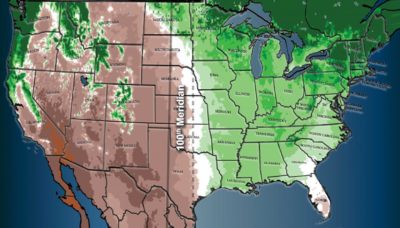Welcome to DU!
The truly grassroots left-of-center political community where regular people, not algorithms, drive the discussions and set the standards.
Join the community:
Create a free account
Support DU (and get rid of ads!):
Become a Star Member
Latest Breaking News
General Discussion
The DU Lounge
All Forums
Issue Forums
Culture Forums
Alliance Forums
Region Forums
Support Forums
Help & Search
Environment & Energy
Related: About this forumClimate Boundary Between Wet East & Dry West USA Now Closer To 98th Meridian, Not 100th Meridian

Climate change has moved the 100th meridian west climatic divide from its historical position (solid line) 140 miles eastward (dotted line) in recent decades. Modified from Seager et al. Earth Interactions, 2018
In the late 1800s, geologist and explorer John Wesley Powell first described a clear boundary running longitudinally through North America along the 100th meridian west that visibly separated the humid eastern part of the continent from the more arid western plains. Now, 140 years later, scientists have confirmed that such a sharp climatic boundary exists and that it is slowly shifting east due to climate change — a change that scientists say could have significant implications on farming in the region.
The new research, published in a pair of studies in the journal Earth Interactions late last month, found the divide is created by three factors: the Rocky Mountains stopping moisture from the Pacific Ocean reaching farther inland, Atlantic winter storms bringing moisture to the eastern half of the U.S., and moisture from the Gulf of Mexico moving north and curving eastward during the summer months. The only other clear, straight divide between humid and arid areas on the globe is the one separating the Sahara Desert from the rest of Africa, climate scientist Richard Seager of Columbia University, lead author of the new papers, said in a statement.
Seager and his colleagues wanted to study the boundary as an example of “psychogeography” — how environmental conditions affect human decisions. “Powell talked eloquently about the 100th meridian, and this concept of a boundary line has stayed with us down to the current day,” said Seager. “We wanted to ask whether there really is such a divide, and whether it’s influenced human settlement.”
The divide cuts through eastern Mexico, Texas, Oklahoma, Kansas, Nebraska, the Dakotas, and the Canadian province of Manitoba. West of the 100th meridian, population density declines and development is sparse, and farms are larger and primarily depend on arid-resistant crops like wheat. To the more humid east, more people and infrastructure exist. Farms are smaller and 70 percent of the harvested crop is moisture-loving corn. Studying rainfall and temperature data since 1980, Seager and his colleagues found this climatic boundary has already shifted east about 140 miles so that it now sits closer to the 98th meridian. And it will continue to move east as warming global temperatures increase evaporation from the soil and change precipitation patterns, they concluded.
EDIT
https://e360.yale.edu/digest/a-north-american-climate-boundary-has-shifted-140-miles-east-due-to-global-warming
InfoView thread info, including edit history
TrashPut this thread in your Trash Can (My DU » Trash Can)
BookmarkAdd this thread to your Bookmarks (My DU » Bookmarks)
1 replies, 1380 views
ShareGet links to this post and/or share on social media
AlertAlert this post for a rule violation
PowersThere are no powers you can use on this post
EditCannot edit other people's posts
ReplyReply to this post
EditCannot edit other people's posts
Rec (6)
ReplyReply to this post
1 replies
 = new reply since forum marked as read
Highlight:
NoneDon't highlight anything
5 newestHighlight 5 most recent replies
= new reply since forum marked as read
Highlight:
NoneDon't highlight anything
5 newestHighlight 5 most recent replies
Climate Boundary Between Wet East & Dry West USA Now Closer To 98th Meridian, Not 100th Meridian (Original Post)
hatrack
Apr 2018
OP
yonder
(9,666 posts)1. Stegner's "Beyond the 100th Meridian"
explores Powell's understanding of the West and his efforts to get Washington, DC to acknowledge that in so many ways, the West is NOT the East. This is really a good book and better yet, Wallace Stegner wrote it.
Thanks for the post, hatrack